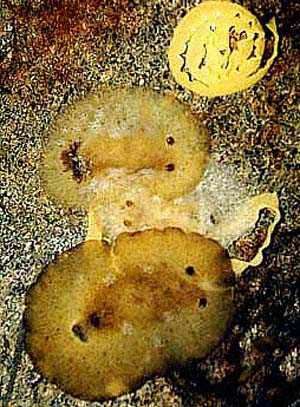
Platydoris galbanus
Burn, 1958
Order: NUDIBRANCHIA
Suborder: DORIDINA
Family: Dorididae
DISTRIBUTION
Southeastern Australia. Reported from Victoria, and now from mid New South Wales.
PHOTO
Wollongong, intertidal. Photo: Kirsten Benkendorff.
The only published information on this species is the original description which I summarise below. The accompanying photo, from New South Wales, is tentatively identified as this species.
"Body small, length 40mm, breadth 24 mm. Body-shape broadly elliptic, rather flat. Mantle leathery to the touch, minutely granular all over; expanded well beyond the foot. It has 5 very large and bushy quadripinnate gills, with the anus protruding between the rear pair. The edge of the gill cavity is folded into 5 broad, indistinct valves. The margin of the rhinophore sheaths are crenulate. The rhinophores are relatively small, the perfoliate club apparently narrower than the stalk, with 10 steeply-angled laminae. The oral tentacles are digitiform anfd the head is rounded. Foot narrow, grooved anteriorly, not extending beyond posterior margin of mantle. Body colour yellow, of a very bright hue; mantle with a few medium-sized white spots. Rhinophores and branchiae chocolate-brown. Radula formula 18 x 30.0.30 with all teeth hamate or hookshaped and non denticulate.
Known from two specimens collected under a rock at Phillip Island in Jan 1957." [summarised from Burn, 1958]
Reference:
• Burn, R.F. (1958). Further Victorian opisthobranchia. Journal of the malacological Society of Australia, 2: 20-36
Rudman, W.B., 2003 (July 11) Platydoris galbanus Burn, 1958. [In] Sea Slug Forum. Australian Museum, Sydney. Available from http://www.seaslugforum.net/find/platygal
Related messages
Re: Communally spawning Discodoris
April 28, 1998
From: Richard Willan
Dear Bill,
I am fairly confident in calling the dorid from Wollongong Platydoris galbanus Burn, 1958. The characters that match for genus are the broad elliptic flattened smooth mantle and lobed branchial pocket, and those that match for species are coloration - yellow mantle with medium-sized white spots and chocolate brown rhinophores and gills. The type locality is Philip Island, central Victoria, and there are apparently no published records from NSW, but that is no surprise. The animals are definitely not southern populations of any tropical species of Platydoris.
Cheers,
Richard Willan
richard.willan@nt.gov.au
Willan, R., 1998 (Apr 28) Re: Communally spawning Discodoris. [Message in] Sea Slug Forum. Australian Museum, Sydney. Available from http://www.seaslugforum.net/find/116Thanks Richard,
Bill Rudman
Communally spawning Discodoris
April 13, 1998
From: Kirsten Benkendorff

Hi Bill,
I find several species of Opisthobranchs which suddenly appear in the intertidal area, lay their eggs and then disappear. One such species is this communally spawning Discodoris, which I do not yet have a species name for. Can you help with a name?
Cheers,
Kirsten Benkendorff
University of Wollongong, NSW 2522
kb06@uow.edu.au
Benkendorff, K., 1998 (Apr 13) Communally spawning Discodoris. [Message in] Sea Slug Forum. Australian Museum, Sydney. Available from http://www.seaslugforum.net/find/115Its either a Discodoris or Platydoris. It may be a southern species at the northern extent of its range. It does seem to be a tropical species at the southern end of its range. I have asked Richard Willan if he has any ideas
Bill Rudman
